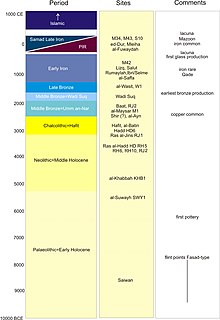
The present-day Sultanate of Oman lies in the south-eastern Arabian Peninsula. There are different definitions for Oman: traditional Oman includes the present-day United Arab Emirates (U.A.E.), though its prehistoric remains differ in some respects from the more specifically defined Oman proper, which corresponds roughly with the present-day central provinces of the Sultanate. In the north, the Oman Peninsula is more specific, and juts into the Strait of Hormuz. The archaeology of southern Oman Dhofar develops separately from that of central and northern Oman.
Different ages are reflected in typological assemblages, Old Stone (Paleolithic) Age, New Stone (Neolithic) Age, Copper Age, Bronze Age, Early Iron Age, Late Iron Age, and the Age of Islam. A "period" is an inferred classification from recurring artifact assemblages, sometimes associated with cultures. Ages, on the other hand, are on a much larger scale; they are conventional, but difficult to date absolutely—partially due to different rates of regional development. A barometer of transition is the amount of industry and manufacturing going on, particularly that of copper—refused as slag—and other metallic artifacts. The absolute dates for the different periods are still under study and it is difficult to assign years to the Late Iron Age of central and southern Oman. Even major monuments have been dated variously, spanning millennia. (moved from the last paragraph)
Archaeologically speaking, differences increase between the area of the present-day U.A.E. and the Sultanate particularly toward the end of the Early Iron Age, conditioned locally by the different geographical situations. The amount of moisture dictates the carrying capacity of the area, with a variety of subsistence strategies used to exploit the available resources. Since archaeological field work began in the early 1970s, numerous teams have worked in the Sultanate.